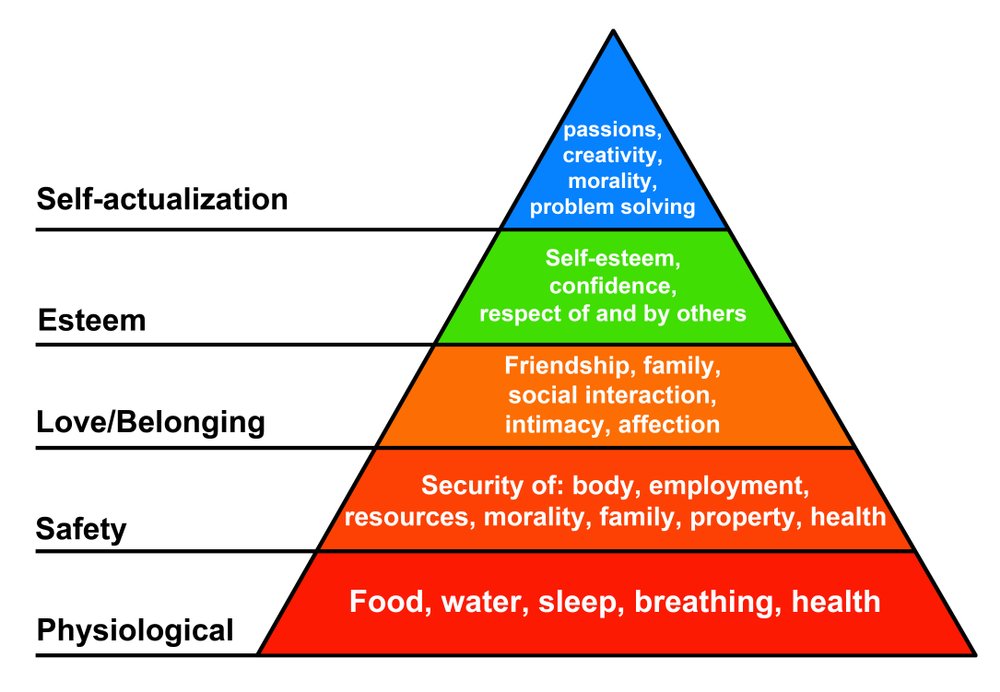Elevating Fitness Coaching: Maslow's Hierarchy of Needs for Personal Trainers
As personal trainers, we navigate the ever-evolving landscape of fitness, constantly striving to comprehend our clients' motivations and requirements. It's imperative for us to fathom the underlying factors propelling our clients towards enhancing their health and overall well-being.
While we excel in tailoring exercise routines to match our clients' physical capabilities, we must also acknowledge the broader psychological dimension. Gaining insight into the fundamental principles of motivation and human needs is pivotal in crafting genuinely effective fitness programmes.
Overlooking this psychological aspect can lead to clients grappling with the struggle to muster motivation for their workout commitments. This, in turn, may result in inconsistent progress and, ultimately, impact their overall fitness journey.
In this blog post, we'll delve into Abraham Maslow's pioneering theory of human motivation – the Hierarchy of Needs. This framework will furnish us with priceless insights into the various layers of human motivation, commencing with the rudimentary physiological needs and advancing towards the pinnacle of self-actualization. By comprehending these needs and their intricate interplay, we can devise fitness programmes that not only cater to the physical aspect but also tend to the emotional and psychological facets of our clients' well-being. Whether you're an experienced trainer or new to the fitness industry, assimilating this comprehension into your training methodology will empower you to design all-encompassing and exceedingly efficient workout plans, ultimately aiding your clients in attaining their fitness aspirations.
Who was Abraham Maslow?
Abraham Maslow (1 April 1908 - 8 June 1970) was an American psychologist best known for his theory of self-actualization. He was head of the psychology department at Brandeis University in 1951 and remained so until 1969.
In response to Sigmund Freud’s psychoanalytic and B.F. Skinner’s behaviourist theories, which focus on mental illness and environmental control respectively, Maslow established the need for a humanistic movement in psychology, focusing on mental health and human potential.
In his major work, Motivation and Personality (1954), Maslow argued that people have a hierarchy of needs, ranging from basic physiological requirements to safety, love, esteem and finally, self-actualization.
What problem was Maslow trying to solve?
Maslow wanted to propose a theory that satisfied 17 assumptions about motivation:
That an individual is motivated holistically, their whole being is motivated rather than some isolated part.
That hunger is a special case of motivation rather than the general one.
That motivations are usually a means to an end.
That motivations are often unconscious.
That the ultimate motivations of all human beings do not differ much.
That a conscious motivation may serve as a channel for other motivations.
That almost any state that an organism is in will typically also be a motivational state.
That satisfactions of motivations generate new motivations.
That it is impossible to list all motivations.
That motivations may be classified according to fundamental needs.
That animal data on motivation is inadequate unless used cautiously and wisely.
That motivations rarely actualize themselves except in relation to a given environment.
That actions are normally integrated, including apparently isolated actions.
That not all behaviours or reactions are motivated.
That motivations usually aim at what is possible.
That motivations are affected by reality.
That a theory of motivation must cover healthy as well as unhealthy individuals.
What was Maslow’s solution?
Maslow’s solution was a holistic-dynamic theory of human motivation, also known as Maslow’s Hierarchy of Needs, by which he built upon three traditions in psychology:
The functionalist tradition of William James and John Dewey.
The gestalt tradition of Max Wertheimer and Kurt Goldstein.
The psychodynamic tradition of Erich Fromm, Karen Horney, Wilhelm Reich, Carl Jung, and Alfred Adler.
Functionalism is rooted in evolutionary thinking and focuses on the utility or purpose of behaviour selected for over the history of human existence.
Gestalt (literally, 'shape') psychology explains perception and behaviour in terms of whole patterns that are not merely the sum of individual parts.
Psychodynamic psychology focuses on the relationship between unconscious and conscious emotions and behaviour, and how these might relate to past experience.
The Hierarchy of Needs
Maslow posited a hierarchy of needs in the sense that once a given (lower) need is satisfied, other (higher) needs emerge, and once these needs are satisfied, again other (even higher) needs emerge, and so on.
The Physiological Needs
At the base of the hierarchy, Maslow places physiological needs, which refer to:
Homeostasis, the body’s automatic efforts to maintain a normal state.
Appetites of hunger, thirst and sex as indicators of actual bodily needs.
The Safety Needs
If the physiological needs are relatively well met, a new range of motivations emerge which may be grouped as safety needs, including: security, stability, dependency, protection, freedom from fear, freedom from anxiety, freedom from chaos, need for structure, need for order, need for law, need for limits, need for strength in the protector, and so on.
The Belongingness and Love Needs
If the safety needs are relatively well met, again a new range of motivations emerge grouped as belongingness and love needs. These include: the giving and receiving of affection within a stable group of friends, neighbours, work colleagues, etc. When these needs are unmet, the individual feels the pangs of loneliness, ostracism, rejection, and rootlessness.
The Esteem Needs
If the belongingness needs are relatively well met, once again a new range of motivations emerge, which Maslow calls the esteem needs. These are classified into two groups:
Competence: achievement, adequacy, mastery, strength, independence, freedom, confidence in the face of the world, etc.
Prestige: respect, status, fame, glory, dominance, recognition, attention, importance, dignity, appreciation, esteem from other people, etc.
When these needs are met, the individual feels self-confident, worthy, strong, capable, adequate, useful and necessary in the world. When unmet, the individual feels inferior, weak and helpless. Maslow notes that the most stable and therefore healthy self-esteem is based on actual competence and deserved respect.
The Self-Actualization Needs
If all the above needs are relatively well met, a new range of motivations emerge which Maslow calls the self-actualization needs. These include: the desire of an individual to do what he or she individually is fitted for, the desire to be true to one’s own nature, the desire for self-fulfilment, the tendency to actualize what one is potentially, the desire to become everything that one is capable of becoming, the desire to become more and more what one idiosyncratically is, and so on.
How did Maslow evaluate his solution?
Maslow acknowledges that his hierarchy suggests a fixed order to human motivation but qualifies this by stating that it is not as rigid as implied. For example, some individuals may strive for self-actualization despite their physiological needs being poorly met, and some individuals may place belongingness above the need for esteem.
Maslow also acknowledges, but offers no definitive answers to, three needs that do not fit neatly into the hierarchy, namely:
Ethical Prerequisites: justice, fairness, honesty, the freedom to speak, freedom to seek information, freedom to defend oneself, orderliness in the group, freedom to act so long as no harm is done to others, etc.
Cognitive Needs: curiosity, learning, philosophizing, experimenting, etc.
Aesthetic Needs: the desire for beauty, symmetry, closure, completion, etc.
Questions
Why does the hierarchy stop at self-actualization? Is it universally accepted that this is the highest human motivation?
If the hierarchy is not as rigid as implied, what accounts for the flexibility?
Are ethical prerequisites, cognitive needs and aesthetic needs examples of non-hierarchical needs? If so, what kind of theory would account for both hierarchical and non-hierarchical needs?
References
Britannica, T. Editors of Encyclopaedia (2022, June 23). Abraham Maslow. Encyclopedia Britannica. https://www.britannica.com/biography/Abraham-H-Maslow
Maslow, A., Frager, R. and Fadiman, J., 1970. Motivation and Personality. 3rd ed. New Delhi: Addison-Wesley Longman.
Wikipedia contributors. (2022, August 18). Abraham Maslow. In Wikipedia, The Free Encyclopedia. Retrieved 09:26, August 25, 2022, from https://en.wikipedia.org/w/index.php?title=Abraham_Maslow&oldid=1105089537

